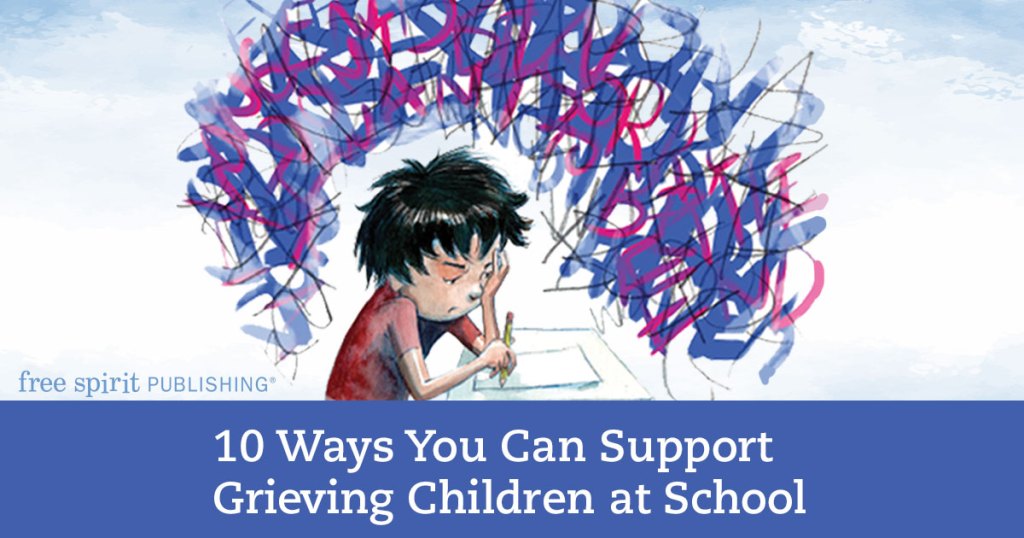By Korie Leigh, Ph.D., author of What Does Grief Feel Like?
In your classroom, you have a grieving student. In fact, you probably have more than one. By 18, one in every 12 children will have experienced the death of a parent or sibling.
When you include the losses of other family members like grandparents, aunts, uncles, community members like classmates, or even teachers, you can see just how common the experience of childhood grief is. In any given elementary classroom across the United States, you can find at least two to three students that have experienced the death of someone they love.
As an educator, you can support the grief experience of your students. Teachers who intentionally provide support by listening and responding with empathy can be a positive force. Below are ten ways to support grieving children in your classroom or your school.
1. Talk with your students using open-ended questions and statements.
Instead of saying, “I know how you feel,” try, “Can you tell me more about what this has been like for you?” or instead of saying, “You must be feeling so sad,” try, “Can you tell me what you are feeling right now?”
2. Grief impacts the way students learn.
Grief affects many parts of the brain, including the ability to focus and concentrate. Short-term memory is impacted. You may notice students zoning out or unable to retain new information. This is a normal part of the grief experience.
3. Grief is a lifelong developmental process for children.
A loss that occurs when a child is three will be re-grieved as they continue to grow and develop. When that same child reaches the age of seven, they may, for the first time, really understand the finality of their loss.
In my own practice, this very thing happened. A seven-year-old was making Father’s Day gifts in class, and his dad died when he was three. During that class, it was the first time he realized his dad was never coming home and to die means to die forever.
Developmentally this makes sense as this child was entering a new stage of cognitive development and forming the ability to navigate abstract concepts with more mastery.
4. Listen more, talk less.
As adults, we like to fill space with our words. Yet, sometimes what children need is for the adults in their life to just listen. Not ask questions, not probe with inquiries, simply sit with them, play with them, and really listen to what they are saying with their words, their behaviors, and their emotions.
5. Grieving students may feel different from their peers.
Educators can strengthen grieving students’ social connectedness with their peers to reduce isolation and encourage emotional expression. However, there is a delicate balance to walk. On the one hand, you know that grieving students have unique needs. On the other, these same students don’t want to be singled out for this difference.
Instead of excluding these students from experiences, such as excusing them from making Mother’s Day cards if their mom dies. Try to invite them to make a card in honor or memory of their mom or ask what the student wants to make. That student still has a mom but is now navigating life as a child without a living mother.
6. Make space for the class to learn about grief.
Use literature and children’s books to support learning about and expressing grief. Many well-written psychotherapeutic books can help you find the words to talk about such challenging topics.
7. Your grief is not your student’s grief.
Since grief is a normal experience, we have all had our own losses and our own unique grief experiences. It’s important to remember that a child’s grief experience is unique to them. Some may cry, some may not. Some may want to talk about it, others may not. When supporting grieving students, it’s helpful to recognize that how grief feels to you isn’t necessarily how grief feels for your student. Do your best to meet your students where they are and validate their grief experience.
There is no right or wrong way to grieve, and there are no stages or end point to the grief process.
8. Develop a code or sign for overwhelm.
Grieving students will have times during the day when they feel emotionally overwhelmed. To prepare for these times, create a sign, signal, or something that you can see that tells you the student is having a hard time.
One client I worked with decided that her sign would be to put her hair in a ponytail because she always wore it down. When the teacher saw this sign, they would tell the student they could go to the counselor’s office or opt out of doing work at that time.
9. Be flexible and gentle . . . with yourself.
You’ll make mistakes. It’s normal. If you realize you may have said or done something that you feel may not have supported your grieving students, you can always talk with them about it. Or, if that is not appropriate, you can learn from those experiences and work towards changing the way you engage with topics of death and grief.
10. Grief is a normal part of loss.
As an educator, you are uniquely positioned to use teachable moments as touchpoints for lifelong social-emotional capacity. The way you approach and hold experiences of death and grief will inform the way your students cope with grief and loss.
This means that you, as the adult, must learn where your own struggles and challenges are with talking about such emotional topics. Children will pick up on subtle emotional cues; if you’re uncomfortable or nervous, they will feel that.
Resources for educators
 With training as a child life specialist and grief counselor, Dr. Korie Leigh has spent over 16 years specializing in working with children and families experiencing grief and loss. As an associate professor and program director, she teaches graduate courses on child development, death, dying, and bereavement. Dr. Leigh obtained her Ph.D. in transpersonal psychology, where she wrote her dissertation on the lived experiences of bereaved parents. She also holds an M.A. in public health and grief counseling and a B.A. in child development. She speaks and presents at national and regional conferences on issues of grief, loss, and coping. Dr. Leigh lives in Santa Fe, New Mexico.
With training as a child life specialist and grief counselor, Dr. Korie Leigh has spent over 16 years specializing in working with children and families experiencing grief and loss. As an associate professor and program director, she teaches graduate courses on child development, death, dying, and bereavement. Dr. Leigh obtained her Ph.D. in transpersonal psychology, where she wrote her dissertation on the lived experiences of bereaved parents. She also holds an M.A. in public health and grief counseling and a B.A. in child development. She speaks and presents at national and regional conferences on issues of grief, loss, and coping. Dr. Leigh lives in Santa Fe, New Mexico.
Korie Leigh is the author of What Does Grief Feel Like?:
We welcome your comments and suggestions. Share your comments, stories, and ideas below, or contact us. All comments will be approved before posting, and are subject to our comment and privacy policies.
![]() © 2023 by Free Spirit Publishing. All rights reserved. The views expressed in this post represent the opinion of the author and not necessarily Free Spirit Publishing.
© 2023 by Free Spirit Publishing. All rights reserved. The views expressed in this post represent the opinion of the author and not necessarily Free Spirit Publishing.




